Analysis of Origin Energy's Australian Pacific LNG Project Case Study
VerifiedAdded on 2020/04/07
|5
|2742
|197
Case Study
AI Summary
This case study focuses on Origin Energy, an Australian energy company, and its involvement in the Australian Pacific LNG (APLNG) project. The study provides a description of Origin Energy, detailing its business activities, including natural gas extraction, energy generation, and retail. It outlines the APLNG project, a collaboration with ConocoPhillips and Sinopec, emphasizing its scope, timeline, and key components such as gas field development, pipeline construction, and facility development on Curtis Island. The rationale behind the case study is the interest in the energy sector and the company's diverse operations. The methodology includes data collection through interviews, surveys, and record analysis. A timeline is provided, outlining key tasks and goals associated with the project's various stages, from site investigation to project completion analysis. The case study also highlights compliance with governmental standards and the assessment of environmental impacts.
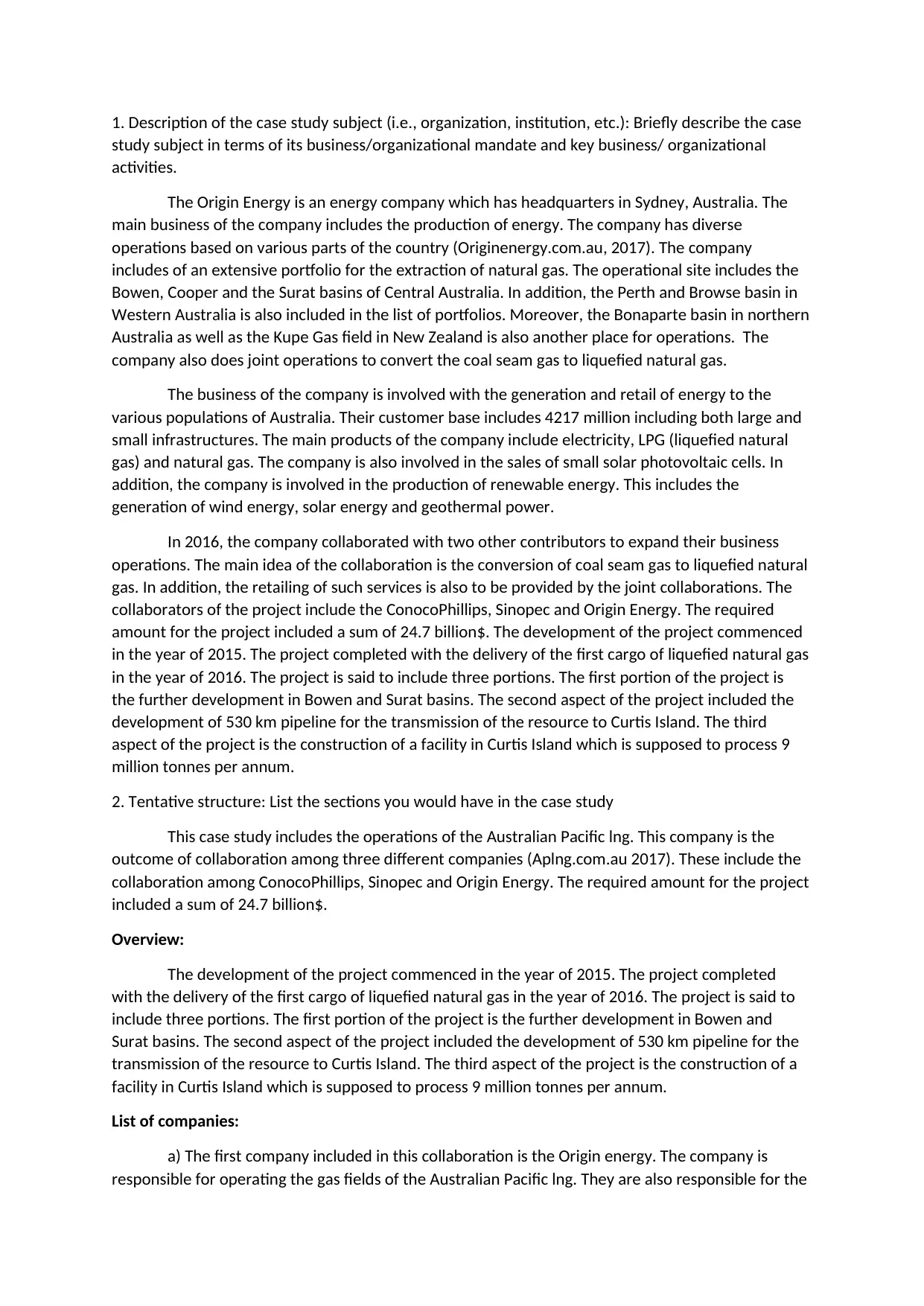
1. Description of the case study subject (i.e., organization, institution, etc.): Briefly describe the case
study subject in terms of its business/organizational mandate and key business/ organizational
activities.
The Origin Energy is an energy company which has headquarters in Sydney, Australia. The
main business of the company includes the production of energy. The company has diverse
operations based on various parts of the country (Originenergy.com.au, 2017). The company
includes of an extensive portfolio for the extraction of natural gas. The operational site includes the
Bowen, Cooper and the Surat basins of Central Australia. In addition, the Perth and Browse basin in
Western Australia is also included in the list of portfolios. Moreover, the Bonaparte basin in northern
Australia as well as the Kupe Gas field in New Zealand is also another place for operations. The
company also does joint operations to convert the coal seam gas to liquefied natural gas.
The business of the company is involved with the generation and retail of energy to the
various populations of Australia. Their customer base includes 4217 million including both large and
small infrastructures. The main products of the company include electricity, LPG (liquefied natural
gas) and natural gas. The company is also involved in the sales of small solar photovoltaic cells. In
addition, the company is involved in the production of renewable energy. This includes the
generation of wind energy, solar energy and geothermal power.
In 2016, the company collaborated with two other contributors to expand their business
operations. The main idea of the collaboration is the conversion of coal seam gas to liquefied natural
gas. In addition, the retailing of such services is also to be provided by the joint collaborations. The
collaborators of the project include the ConocoPhillips, Sinopec and Origin Energy. The required
amount for the project included a sum of 24.7 billion$. The development of the project commenced
in the year of 2015. The project completed with the delivery of the first cargo of liquefied natural gas
in the year of 2016. The project is said to include three portions. The first portion of the project is
the further development in Bowen and Surat basins. The second aspect of the project included the
development of 530 km pipeline for the transmission of the resource to Curtis Island. The third
aspect of the project is the construction of a facility in Curtis Island which is supposed to process 9
million tonnes per annum.
2. Tentative structure: List the sections you would have in the case study
This case study includes the operations of the Australian Pacific lng. This company is the
outcome of collaboration among three different companies (Aplng.com.au 2017). These include the
collaboration among ConocoPhillips, Sinopec and Origin Energy. The required amount for the project
included a sum of 24.7 billion$.
Overview:
The development of the project commenced in the year of 2015. The project completed
with the delivery of the first cargo of liquefied natural gas in the year of 2016. The project is said to
include three portions. The first portion of the project is the further development in Bowen and
Surat basins. The second aspect of the project included the development of 530 km pipeline for the
transmission of the resource to Curtis Island. The third aspect of the project is the construction of a
facility in Curtis Island which is supposed to process 9 million tonnes per annum.
List of companies:
a) The first company included in this collaboration is the Origin energy. The company is
responsible for operating the gas fields of the Australian Pacific lng. They are also responsible for the
study subject in terms of its business/organizational mandate and key business/ organizational
activities.
The Origin Energy is an energy company which has headquarters in Sydney, Australia. The
main business of the company includes the production of energy. The company has diverse
operations based on various parts of the country (Originenergy.com.au, 2017). The company
includes of an extensive portfolio for the extraction of natural gas. The operational site includes the
Bowen, Cooper and the Surat basins of Central Australia. In addition, the Perth and Browse basin in
Western Australia is also included in the list of portfolios. Moreover, the Bonaparte basin in northern
Australia as well as the Kupe Gas field in New Zealand is also another place for operations. The
company also does joint operations to convert the coal seam gas to liquefied natural gas.
The business of the company is involved with the generation and retail of energy to the
various populations of Australia. Their customer base includes 4217 million including both large and
small infrastructures. The main products of the company include electricity, LPG (liquefied natural
gas) and natural gas. The company is also involved in the sales of small solar photovoltaic cells. In
addition, the company is involved in the production of renewable energy. This includes the
generation of wind energy, solar energy and geothermal power.
In 2016, the company collaborated with two other contributors to expand their business
operations. The main idea of the collaboration is the conversion of coal seam gas to liquefied natural
gas. In addition, the retailing of such services is also to be provided by the joint collaborations. The
collaborators of the project include the ConocoPhillips, Sinopec and Origin Energy. The required
amount for the project included a sum of 24.7 billion$. The development of the project commenced
in the year of 2015. The project completed with the delivery of the first cargo of liquefied natural gas
in the year of 2016. The project is said to include three portions. The first portion of the project is
the further development in Bowen and Surat basins. The second aspect of the project included the
development of 530 km pipeline for the transmission of the resource to Curtis Island. The third
aspect of the project is the construction of a facility in Curtis Island which is supposed to process 9
million tonnes per annum.
2. Tentative structure: List the sections you would have in the case study
This case study includes the operations of the Australian Pacific lng. This company is the
outcome of collaboration among three different companies (Aplng.com.au 2017). These include the
collaboration among ConocoPhillips, Sinopec and Origin Energy. The required amount for the project
included a sum of 24.7 billion$.
Overview:
The development of the project commenced in the year of 2015. The project completed
with the delivery of the first cargo of liquefied natural gas in the year of 2016. The project is said to
include three portions. The first portion of the project is the further development in Bowen and
Surat basins. The second aspect of the project included the development of 530 km pipeline for the
transmission of the resource to Curtis Island. The third aspect of the project is the construction of a
facility in Curtis Island which is supposed to process 9 million tonnes per annum.
List of companies:
a) The first company included in this collaboration is the Origin energy. The company is
responsible for operating the gas fields of the Australian Pacific lng. They are also responsible for the
Paraphrase This Document
Need a fresh take? Get an instant paraphrase of this document with our AI Paraphraser
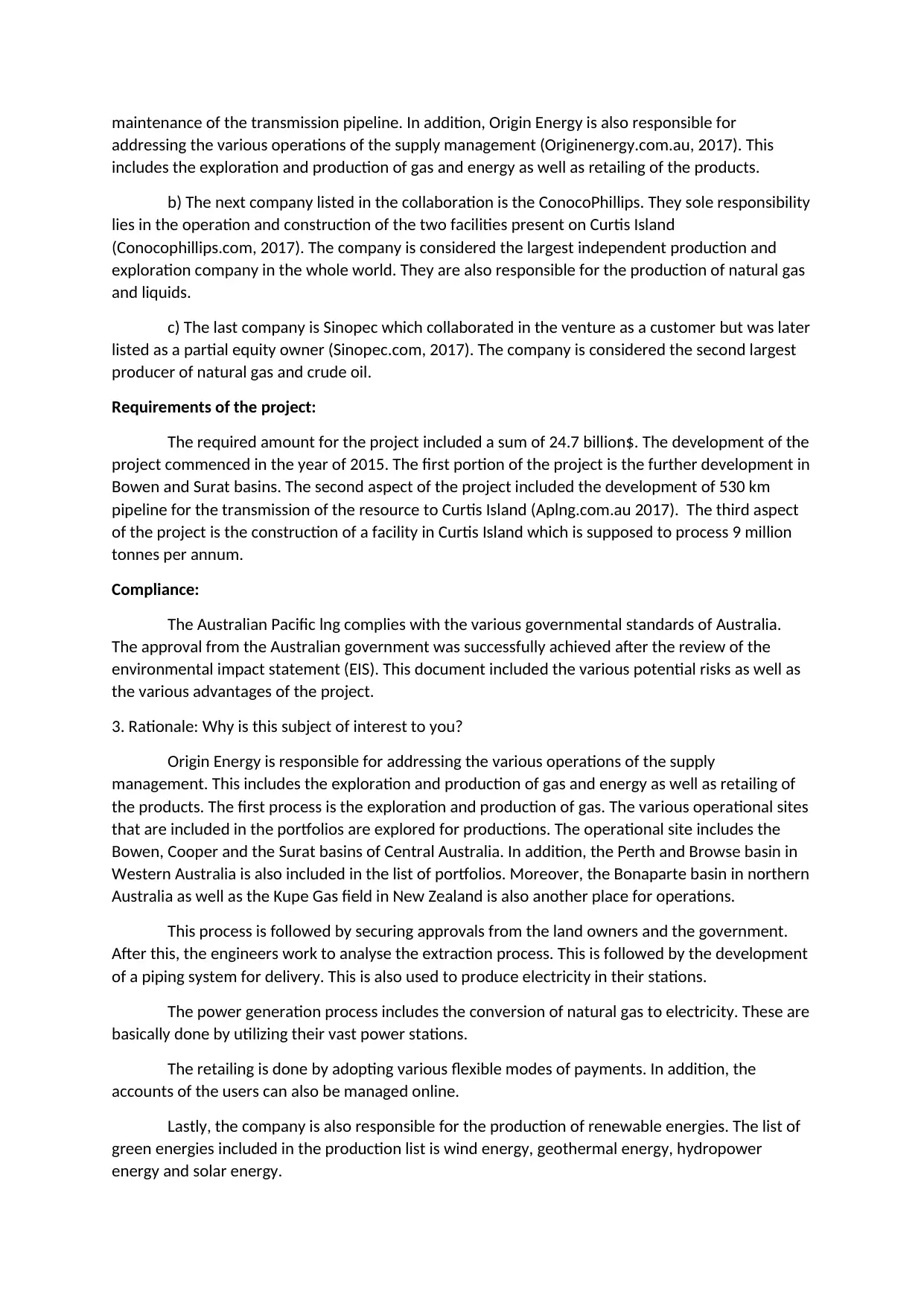
maintenance of the transmission pipeline. In addition, Origin Energy is also responsible for
addressing the various operations of the supply management (Originenergy.com.au, 2017). This
includes the exploration and production of gas and energy as well as retailing of the products.
b) The next company listed in the collaboration is the ConocoPhillips. They sole responsibility
lies in the operation and construction of the two facilities present on Curtis Island
(Conocophillips.com, 2017). The company is considered the largest independent production and
exploration company in the whole world. They are also responsible for the production of natural gas
and liquids.
c) The last company is Sinopec which collaborated in the venture as a customer but was later
listed as a partial equity owner (Sinopec.com, 2017). The company is considered the second largest
producer of natural gas and crude oil.
Requirements of the project:
The required amount for the project included a sum of 24.7 billion$. The development of the
project commenced in the year of 2015. The first portion of the project is the further development in
Bowen and Surat basins. The second aspect of the project included the development of 530 km
pipeline for the transmission of the resource to Curtis Island (Aplng.com.au 2017). The third aspect
of the project is the construction of a facility in Curtis Island which is supposed to process 9 million
tonnes per annum.
Compliance:
The Australian Pacific lng complies with the various governmental standards of Australia.
The approval from the Australian government was successfully achieved after the review of the
environmental impact statement (EIS). This document included the various potential risks as well as
the various advantages of the project.
3. Rationale: Why is this subject of interest to you?
Origin Energy is responsible for addressing the various operations of the supply
management. This includes the exploration and production of gas and energy as well as retailing of
the products. The first process is the exploration and production of gas. The various operational sites
that are included in the portfolios are explored for productions. The operational site includes the
Bowen, Cooper and the Surat basins of Central Australia. In addition, the Perth and Browse basin in
Western Australia is also included in the list of portfolios. Moreover, the Bonaparte basin in northern
Australia as well as the Kupe Gas field in New Zealand is also another place for operations.
This process is followed by securing approvals from the land owners and the government.
After this, the engineers work to analyse the extraction process. This is followed by the development
of a piping system for delivery. This is also used to produce electricity in their stations.
The power generation process includes the conversion of natural gas to electricity. These are
basically done by utilizing their vast power stations.
The retailing is done by adopting various flexible modes of payments. In addition, the
accounts of the users can also be managed online.
Lastly, the company is also responsible for the production of renewable energies. The list of
green energies included in the production list is wind energy, geothermal energy, hydropower
energy and solar energy.
addressing the various operations of the supply management (Originenergy.com.au, 2017). This
includes the exploration and production of gas and energy as well as retailing of the products.
b) The next company listed in the collaboration is the ConocoPhillips. They sole responsibility
lies in the operation and construction of the two facilities present on Curtis Island
(Conocophillips.com, 2017). The company is considered the largest independent production and
exploration company in the whole world. They are also responsible for the production of natural gas
and liquids.
c) The last company is Sinopec which collaborated in the venture as a customer but was later
listed as a partial equity owner (Sinopec.com, 2017). The company is considered the second largest
producer of natural gas and crude oil.
Requirements of the project:
The required amount for the project included a sum of 24.7 billion$. The development of the
project commenced in the year of 2015. The first portion of the project is the further development in
Bowen and Surat basins. The second aspect of the project included the development of 530 km
pipeline for the transmission of the resource to Curtis Island (Aplng.com.au 2017). The third aspect
of the project is the construction of a facility in Curtis Island which is supposed to process 9 million
tonnes per annum.
Compliance:
The Australian Pacific lng complies with the various governmental standards of Australia.
The approval from the Australian government was successfully achieved after the review of the
environmental impact statement (EIS). This document included the various potential risks as well as
the various advantages of the project.
3. Rationale: Why is this subject of interest to you?
Origin Energy is responsible for addressing the various operations of the supply
management. This includes the exploration and production of gas and energy as well as retailing of
the products. The first process is the exploration and production of gas. The various operational sites
that are included in the portfolios are explored for productions. The operational site includes the
Bowen, Cooper and the Surat basins of Central Australia. In addition, the Perth and Browse basin in
Western Australia is also included in the list of portfolios. Moreover, the Bonaparte basin in northern
Australia as well as the Kupe Gas field in New Zealand is also another place for operations.
This process is followed by securing approvals from the land owners and the government.
After this, the engineers work to analyse the extraction process. This is followed by the development
of a piping system for delivery. This is also used to produce electricity in their stations.
The power generation process includes the conversion of natural gas to electricity. These are
basically done by utilizing their vast power stations.
The retailing is done by adopting various flexible modes of payments. In addition, the
accounts of the users can also be managed online.
Lastly, the company is also responsible for the production of renewable energies. The list of
green energies included in the production list is wind energy, geothermal energy, hydropower
energy and solar energy.
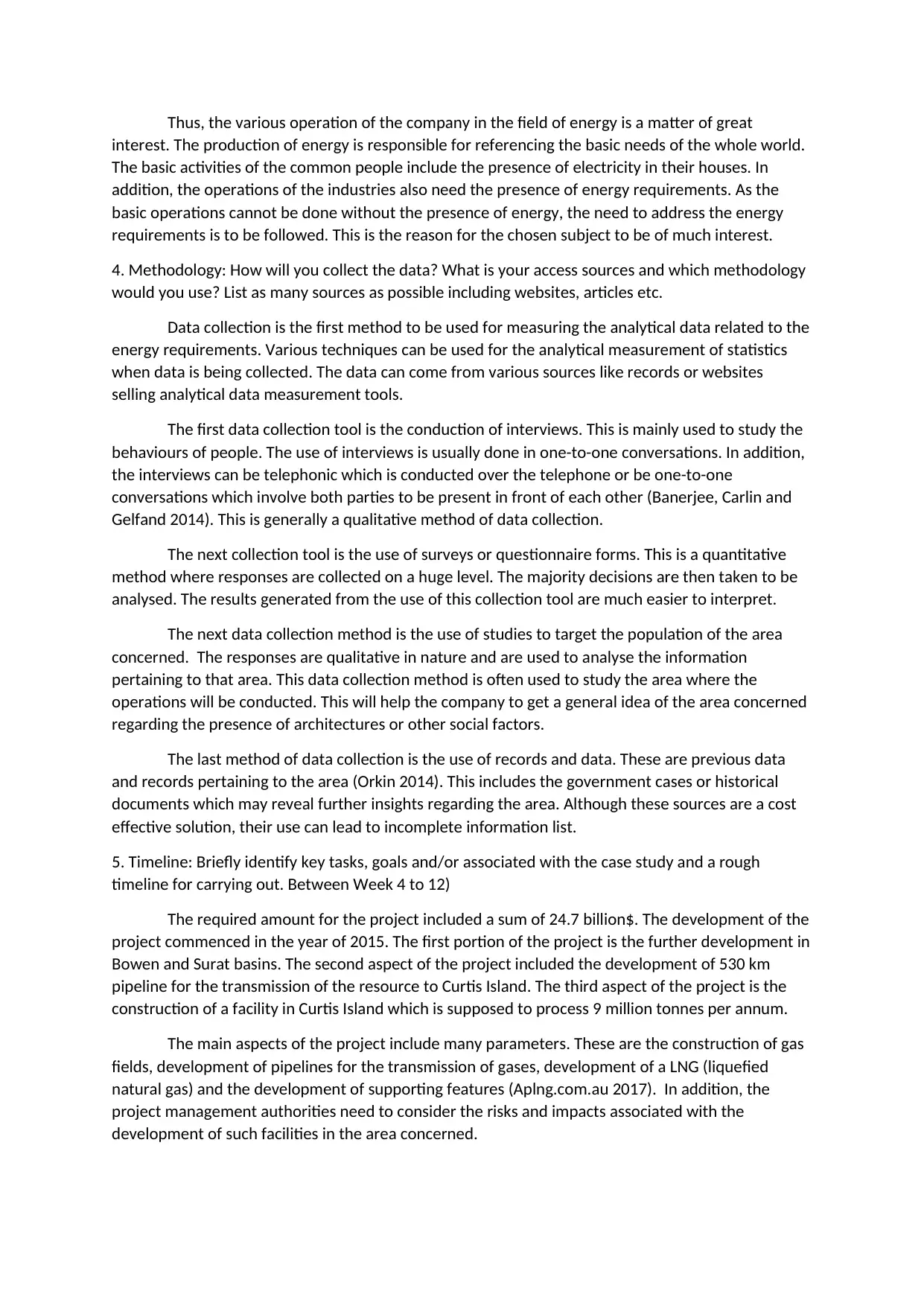
Thus, the various operation of the company in the field of energy is a matter of great
interest. The production of energy is responsible for referencing the basic needs of the whole world.
The basic activities of the common people include the presence of electricity in their houses. In
addition, the operations of the industries also need the presence of energy requirements. As the
basic operations cannot be done without the presence of energy, the need to address the energy
requirements is to be followed. This is the reason for the chosen subject to be of much interest.
4. Methodology: How will you collect the data? What is your access sources and which methodology
would you use? List as many sources as possible including websites, articles etc.
Data collection is the first method to be used for measuring the analytical data related to the
energy requirements. Various techniques can be used for the analytical measurement of statistics
when data is being collected. The data can come from various sources like records or websites
selling analytical data measurement tools.
The first data collection tool is the conduction of interviews. This is mainly used to study the
behaviours of people. The use of interviews is usually done in one-to-one conversations. In addition,
the interviews can be telephonic which is conducted over the telephone or be one-to-one
conversations which involve both parties to be present in front of each other (Banerjee, Carlin and
Gelfand 2014). This is generally a qualitative method of data collection.
The next collection tool is the use of surveys or questionnaire forms. This is a quantitative
method where responses are collected on a huge level. The majority decisions are then taken to be
analysed. The results generated from the use of this collection tool are much easier to interpret.
The next data collection method is the use of studies to target the population of the area
concerned. The responses are qualitative in nature and are used to analyse the information
pertaining to that area. This data collection method is often used to study the area where the
operations will be conducted. This will help the company to get a general idea of the area concerned
regarding the presence of architectures or other social factors.
The last method of data collection is the use of records and data. These are previous data
and records pertaining to the area (Orkin 2014). This includes the government cases or historical
documents which may reveal further insights regarding the area. Although these sources are a cost
effective solution, their use can lead to incomplete information list.
5. Timeline: Briefly identify key tasks, goals and/or associated with the case study and a rough
timeline for carrying out. Between Week 4 to 12)
The required amount for the project included a sum of 24.7 billion$. The development of the
project commenced in the year of 2015. The first portion of the project is the further development in
Bowen and Surat basins. The second aspect of the project included the development of 530 km
pipeline for the transmission of the resource to Curtis Island. The third aspect of the project is the
construction of a facility in Curtis Island which is supposed to process 9 million tonnes per annum.
The main aspects of the project include many parameters. These are the construction of gas
fields, development of pipelines for the transmission of gases, development of a LNG (liquefied
natural gas) and the development of supporting features (Aplng.com.au 2017). In addition, the
project management authorities need to consider the risks and impacts associated with the
development of such facilities in the area concerned.
interest. The production of energy is responsible for referencing the basic needs of the whole world.
The basic activities of the common people include the presence of electricity in their houses. In
addition, the operations of the industries also need the presence of energy requirements. As the
basic operations cannot be done without the presence of energy, the need to address the energy
requirements is to be followed. This is the reason for the chosen subject to be of much interest.
4. Methodology: How will you collect the data? What is your access sources and which methodology
would you use? List as many sources as possible including websites, articles etc.
Data collection is the first method to be used for measuring the analytical data related to the
energy requirements. Various techniques can be used for the analytical measurement of statistics
when data is being collected. The data can come from various sources like records or websites
selling analytical data measurement tools.
The first data collection tool is the conduction of interviews. This is mainly used to study the
behaviours of people. The use of interviews is usually done in one-to-one conversations. In addition,
the interviews can be telephonic which is conducted over the telephone or be one-to-one
conversations which involve both parties to be present in front of each other (Banerjee, Carlin and
Gelfand 2014). This is generally a qualitative method of data collection.
The next collection tool is the use of surveys or questionnaire forms. This is a quantitative
method where responses are collected on a huge level. The majority decisions are then taken to be
analysed. The results generated from the use of this collection tool are much easier to interpret.
The next data collection method is the use of studies to target the population of the area
concerned. The responses are qualitative in nature and are used to analyse the information
pertaining to that area. This data collection method is often used to study the area where the
operations will be conducted. This will help the company to get a general idea of the area concerned
regarding the presence of architectures or other social factors.
The last method of data collection is the use of records and data. These are previous data
and records pertaining to the area (Orkin 2014). This includes the government cases or historical
documents which may reveal further insights regarding the area. Although these sources are a cost
effective solution, their use can lead to incomplete information list.
5. Timeline: Briefly identify key tasks, goals and/or associated with the case study and a rough
timeline for carrying out. Between Week 4 to 12)
The required amount for the project included a sum of 24.7 billion$. The development of the
project commenced in the year of 2015. The first portion of the project is the further development in
Bowen and Surat basins. The second aspect of the project included the development of 530 km
pipeline for the transmission of the resource to Curtis Island. The third aspect of the project is the
construction of a facility in Curtis Island which is supposed to process 9 million tonnes per annum.
The main aspects of the project include many parameters. These are the construction of gas
fields, development of pipelines for the transmission of gases, development of a LNG (liquefied
natural gas) and the development of supporting features (Aplng.com.au 2017). In addition, the
project management authorities need to consider the risks and impacts associated with the
development of such facilities in the area concerned.
⊘ This is a preview!⊘
Do you want full access?
Subscribe today to unlock all pages.

Trusted by 1+ million students worldwide
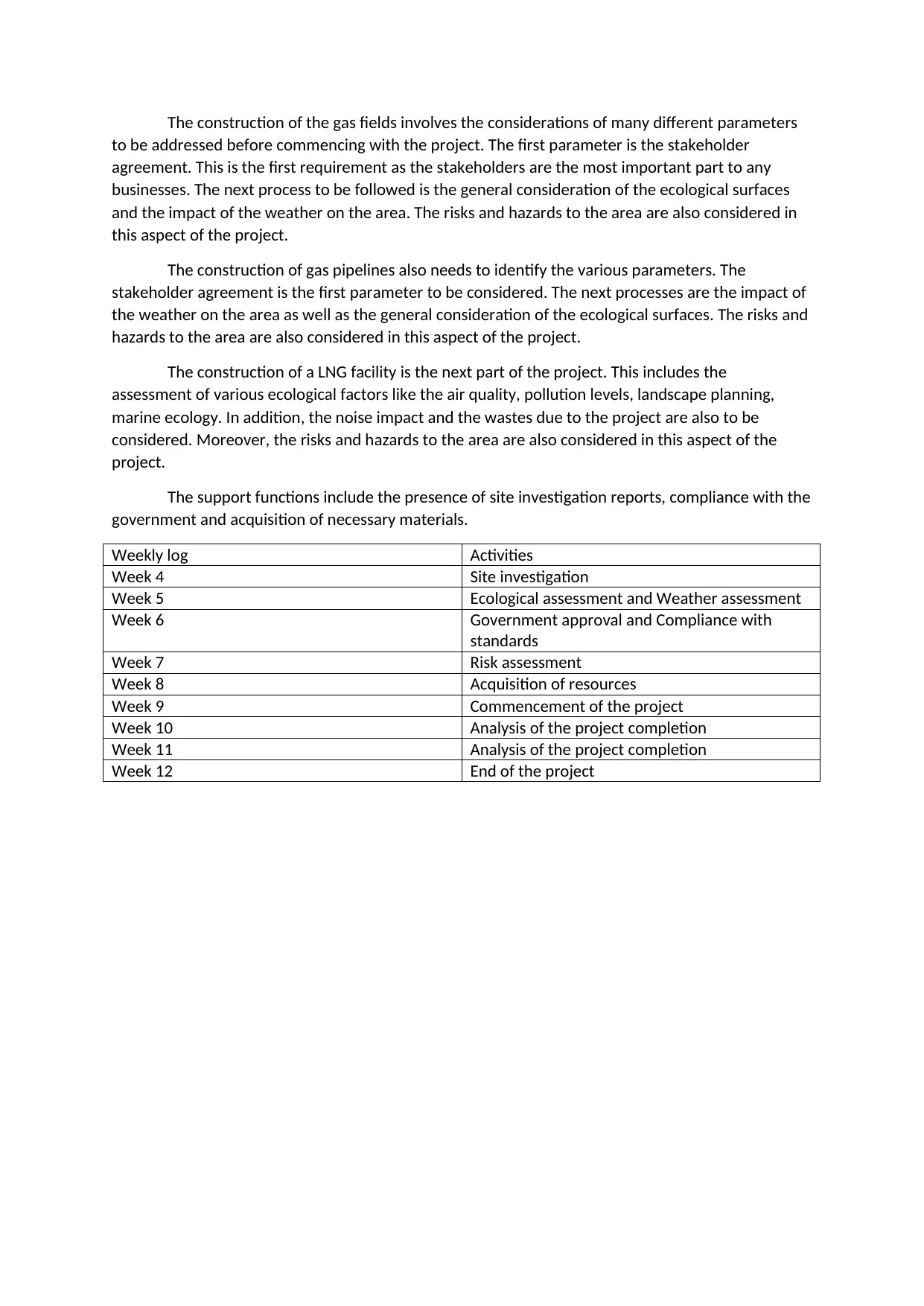
The construction of the gas fields involves the considerations of many different parameters
to be addressed before commencing with the project. The first parameter is the stakeholder
agreement. This is the first requirement as the stakeholders are the most important part to any
businesses. The next process to be followed is the general consideration of the ecological surfaces
and the impact of the weather on the area. The risks and hazards to the area are also considered in
this aspect of the project.
The construction of gas pipelines also needs to identify the various parameters. The
stakeholder agreement is the first parameter to be considered. The next processes are the impact of
the weather on the area as well as the general consideration of the ecological surfaces. The risks and
hazards to the area are also considered in this aspect of the project.
The construction of a LNG facility is the next part of the project. This includes the
assessment of various ecological factors like the air quality, pollution levels, landscape planning,
marine ecology. In addition, the noise impact and the wastes due to the project are also to be
considered. Moreover, the risks and hazards to the area are also considered in this aspect of the
project.
The support functions include the presence of site investigation reports, compliance with the
government and acquisition of necessary materials.
Weekly log Activities
Week 4 Site investigation
Week 5 Ecological assessment and Weather assessment
Week 6 Government approval and Compliance with
standards
Week 7 Risk assessment
Week 8 Acquisition of resources
Week 9 Commencement of the project
Week 10 Analysis of the project completion
Week 11 Analysis of the project completion
Week 12 End of the project
to be addressed before commencing with the project. The first parameter is the stakeholder
agreement. This is the first requirement as the stakeholders are the most important part to any
businesses. The next process to be followed is the general consideration of the ecological surfaces
and the impact of the weather on the area. The risks and hazards to the area are also considered in
this aspect of the project.
The construction of gas pipelines also needs to identify the various parameters. The
stakeholder agreement is the first parameter to be considered. The next processes are the impact of
the weather on the area as well as the general consideration of the ecological surfaces. The risks and
hazards to the area are also considered in this aspect of the project.
The construction of a LNG facility is the next part of the project. This includes the
assessment of various ecological factors like the air quality, pollution levels, landscape planning,
marine ecology. In addition, the noise impact and the wastes due to the project are also to be
considered. Moreover, the risks and hazards to the area are also considered in this aspect of the
project.
The support functions include the presence of site investigation reports, compliance with the
government and acquisition of necessary materials.
Weekly log Activities
Week 4 Site investigation
Week 5 Ecological assessment and Weather assessment
Week 6 Government approval and Compliance with
standards
Week 7 Risk assessment
Week 8 Acquisition of resources
Week 9 Commencement of the project
Week 10 Analysis of the project completion
Week 11 Analysis of the project completion
Week 12 End of the project
Paraphrase This Document
Need a fresh take? Get an instant paraphrase of this document with our AI Paraphraser
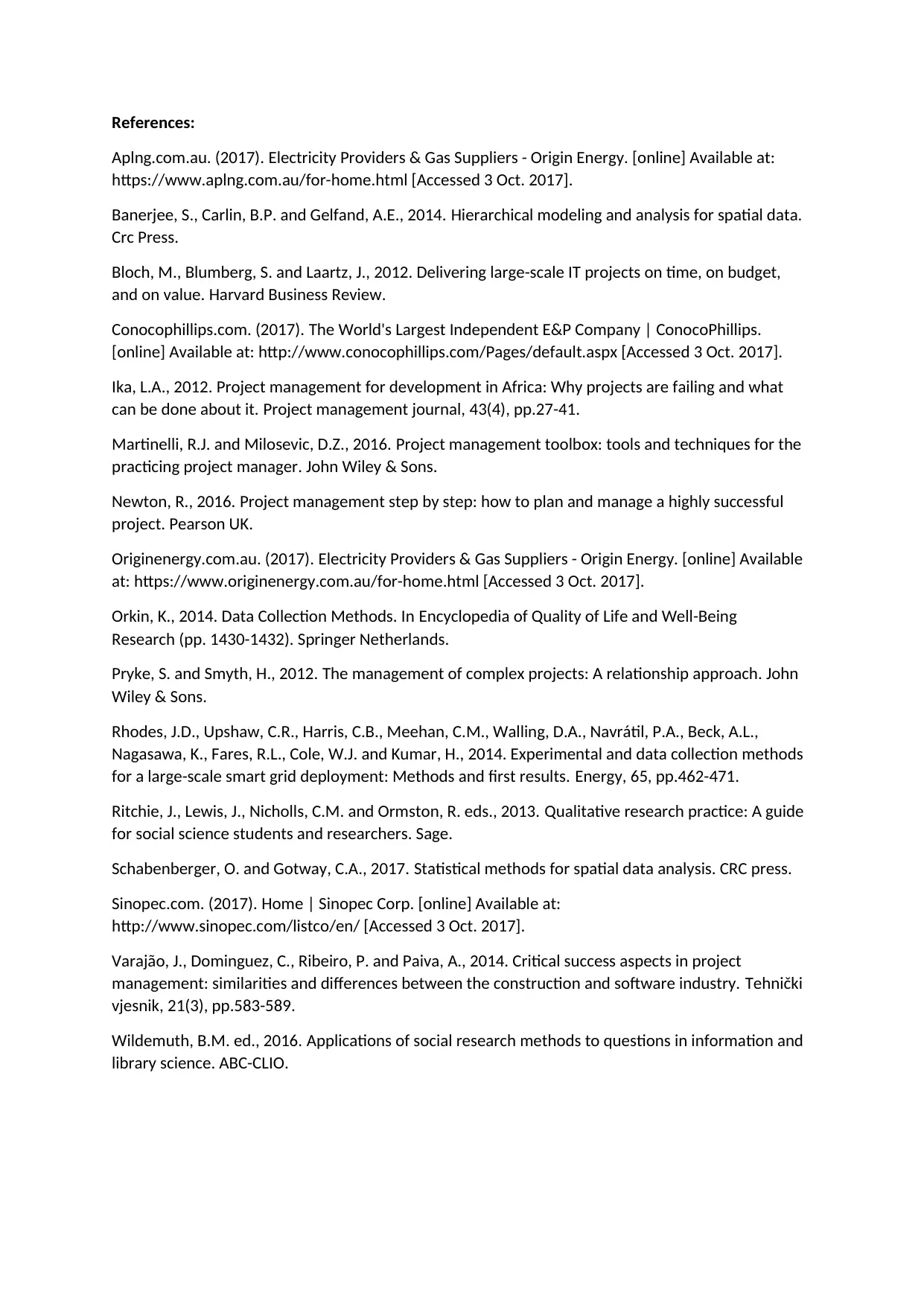
References:
Aplng.com.au. (2017). Electricity Providers & Gas Suppliers - Origin Energy. [online] Available at:
https://www.aplng.com.au/for-home.html [Accessed 3 Oct. 2017].
Banerjee, S., Carlin, B.P. and Gelfand, A.E., 2014. Hierarchical modeling and analysis for spatial data.
Crc Press.
Bloch, M., Blumberg, S. and Laartz, J., 2012. Delivering large-scale IT projects on time, on budget,
and on value. Harvard Business Review.
Conocophillips.com. (2017). The World's Largest Independent E&P Company | ConocoPhillips.
[online] Available at: http://www.conocophillips.com/Pages/default.aspx [Accessed 3 Oct. 2017].
Ika, L.A., 2012. Project management for development in Africa: Why projects are failing and what
can be done about it. Project management journal, 43(4), pp.27-41.
Martinelli, R.J. and Milosevic, D.Z., 2016. Project management toolbox: tools and techniques for the
practicing project manager. John Wiley & Sons.
Newton, R., 2016. Project management step by step: how to plan and manage a highly successful
project. Pearson UK.
Originenergy.com.au. (2017). Electricity Providers & Gas Suppliers - Origin Energy. [online] Available
at: https://www.originenergy.com.au/for-home.html [Accessed 3 Oct. 2017].
Orkin, K., 2014. Data Collection Methods. In Encyclopedia of Quality of Life and Well-Being
Research (pp. 1430-1432). Springer Netherlands.
Pryke, S. and Smyth, H., 2012. The management of complex projects: A relationship approach. John
Wiley & Sons.
Rhodes, J.D., Upshaw, C.R., Harris, C.B., Meehan, C.M., Walling, D.A., Navrátil, P.A., Beck, A.L.,
Nagasawa, K., Fares, R.L., Cole, W.J. and Kumar, H., 2014. Experimental and data collection methods
for a large-scale smart grid deployment: Methods and first results. Energy, 65, pp.462-471.
Ritchie, J., Lewis, J., Nicholls, C.M. and Ormston, R. eds., 2013. Qualitative research practice: A guide
for social science students and researchers. Sage.
Schabenberger, O. and Gotway, C.A., 2017. Statistical methods for spatial data analysis. CRC press.
Sinopec.com. (2017). Home | Sinopec Corp. [online] Available at:
http://www.sinopec.com/listco/en/ [Accessed 3 Oct. 2017].
Varajão, J., Dominguez, C., Ribeiro, P. and Paiva, A., 2014. Critical success aspects in project
management: similarities and differences between the construction and software industry. Tehnički
vjesnik, 21(3), pp.583-589.
Wildemuth, B.M. ed., 2016. Applications of social research methods to questions in information and
library science. ABC-CLIO.
Aplng.com.au. (2017). Electricity Providers & Gas Suppliers - Origin Energy. [online] Available at:
https://www.aplng.com.au/for-home.html [Accessed 3 Oct. 2017].
Banerjee, S., Carlin, B.P. and Gelfand, A.E., 2014. Hierarchical modeling and analysis for spatial data.
Crc Press.
Bloch, M., Blumberg, S. and Laartz, J., 2012. Delivering large-scale IT projects on time, on budget,
and on value. Harvard Business Review.
Conocophillips.com. (2017). The World's Largest Independent E&P Company | ConocoPhillips.
[online] Available at: http://www.conocophillips.com/Pages/default.aspx [Accessed 3 Oct. 2017].
Ika, L.A., 2012. Project management for development in Africa: Why projects are failing and what
can be done about it. Project management journal, 43(4), pp.27-41.
Martinelli, R.J. and Milosevic, D.Z., 2016. Project management toolbox: tools and techniques for the
practicing project manager. John Wiley & Sons.
Newton, R., 2016. Project management step by step: how to plan and manage a highly successful
project. Pearson UK.
Originenergy.com.au. (2017). Electricity Providers & Gas Suppliers - Origin Energy. [online] Available
at: https://www.originenergy.com.au/for-home.html [Accessed 3 Oct. 2017].
Orkin, K., 2014. Data Collection Methods. In Encyclopedia of Quality of Life and Well-Being
Research (pp. 1430-1432). Springer Netherlands.
Pryke, S. and Smyth, H., 2012. The management of complex projects: A relationship approach. John
Wiley & Sons.
Rhodes, J.D., Upshaw, C.R., Harris, C.B., Meehan, C.M., Walling, D.A., Navrátil, P.A., Beck, A.L.,
Nagasawa, K., Fares, R.L., Cole, W.J. and Kumar, H., 2014. Experimental and data collection methods
for a large-scale smart grid deployment: Methods and first results. Energy, 65, pp.462-471.
Ritchie, J., Lewis, J., Nicholls, C.M. and Ormston, R. eds., 2013. Qualitative research practice: A guide
for social science students and researchers. Sage.
Schabenberger, O. and Gotway, C.A., 2017. Statistical methods for spatial data analysis. CRC press.
Sinopec.com. (2017). Home | Sinopec Corp. [online] Available at:
http://www.sinopec.com/listco/en/ [Accessed 3 Oct. 2017].
Varajão, J., Dominguez, C., Ribeiro, P. and Paiva, A., 2014. Critical success aspects in project
management: similarities and differences between the construction and software industry. Tehnički
vjesnik, 21(3), pp.583-589.
Wildemuth, B.M. ed., 2016. Applications of social research methods to questions in information and
library science. ABC-CLIO.
1 out of 5
Your All-in-One AI-Powered Toolkit for Academic Success.
+13062052269
info@desklib.com
Available 24*7 on WhatsApp / Email
![[object Object]](/_next/static/media/star-bottom.7253800d.svg)
Unlock your academic potential
Copyright © 2020–2025 A2Z Services. All Rights Reserved. Developed and managed by ZUCOL.

